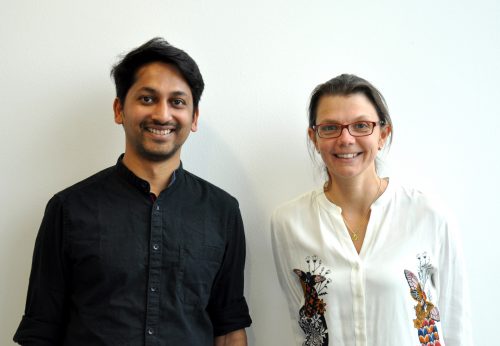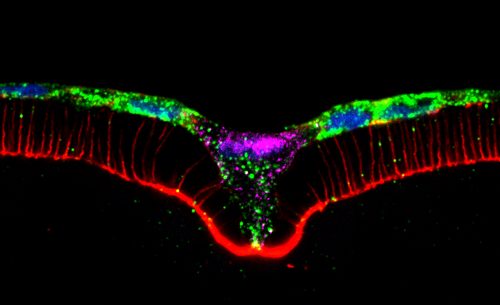The people behind the papers – Chaitanya Dingare and Virginie Lecaudey
Posted by the Node Interviews, on 5 December 2018
This interview, the 52nd in our series, was the first to be published in Development. We’re aiming for one interview per issue, and will continue to put them up here (once the issue has closed).
During teleost fertilisation, sperm fertilises the oocyte through the micropyle, a channel traversing the vitelline membrane at the animal pole. This crucial structure is formed by a specialised micropylar cell (MC) in the follicular epithelium that surrounds the oocyte, but many aspects of MC specification and differentiation remain incompletely understood. A paper from the current issue of Development reveals an unexpected role for the Hippo pathway effector Taz in this process, and hence in fertilisation, in zebrafish. First author and PhD student Chaitanya Dingare and his supervisor Virginie Lecaudey, Professor for Developmental Biology of Vertebrates at the Goethe University of Frankfurt in Germany, told us more about the story.

Virginie, can you give us your scientific biography and the questions your lab is trying to answer?
VL I studied Biology in Paris and did my PhD at the Ecole Normale Supérieure in the lab of Sylvie Schneider-Maunoury. We were interested in the mechanisms underlying the segmentation of the vertebrate hindbrain; this is when I started to work with zebrafish. During this time, I developed a solid background in molecular biology and a passion for developmental biology. Then in 2005 I joined Darren Gilmour at the European Molecular Biology Laboratory (EMBL) in Heidelberg as his lab was just starting. There I started to use the zebrafish lateral line primordium as a model of dynamically remodelling epithelium, and truly enjoyed the extraordinary scientific and international environment of the EMBL. These years were influential in my career, not only because of the amount of things I learned, but also because of the amazing people I met there, and who are now my colleagues, my collaborators and my friends. In 2009, I got the opportunity to start my own lab as a Junior Professor at the University of Freiburg, within the BIOSS Centre for Biological Signalling Studies excellence cluster. We started to focus on the mechanisms that underlie cell shape changes in epithelia and how this drives morphogenesis and organogenesis. After spending 5 years in Freiburg, in 2015 I was appointed as a full professor at the Goethe University of Frankfurt.
My lab is still focusing on how cells coordinate their behaviours to assemble coherent and functional tissues and organs during development. For this purpose, we have mainly been using the lateral line primordium, which is a beautiful system to understand how cell proliferation, cell migration, cell shape changes and cell differentiation are orchestrated in a tissue that is undergoing morphogenesis. In addition, as a group of cells that migrate superficially in a transparent embryo, this is also an ideal system to use to follow these processes in real time within a living organism using high-resolution microscopy. More recently, we have started to look at another epithelium, the follicle cell layer that surrounds the oocyte, and in particular one cell within it: the micropylar cell (MC).
Chaitanya, how did you come to join the Lecaudey lab, and what drives your research?
CD After 2 years of research experience at the Tata Institute for Fundamental Research in Mumbai, I was looking for a PhD position involving zebrafish genetics and morphogenesis. Among other places in Europe, I had applied to Virginie’s lab in Freiburg as the focus of the lab was on studying various cellular behaviours in a very dynamic system, the lateral line primordium.
The major force that drives my research is the frequent stimulating and motivating discussions with Virginie, neighbouring lab members, my friends and my colleagues. Another personally important aspect of doing research is to try and look at my results without having any ‘favourite’ hypothesis in mind: this makes a huge difference as it gives some flexibility to explore more options. I also personally believe that collaborations play a major role in research, in particular when you start working on a completely new question and lack some expertise. This is reflected in our current story as well. Finally, the strong support of my supervisor, a productive research environment and, last but not least, extremely supportive colleagues: all of these aspects play a pivotal role in my research.
How did you come to be interested in zebrafish fertilisation?
CD Our current story is all about serendipity. As I joined Virginie’s lab, I started to analyse the role of Yap and Taz in the lateral line primordium. For that, we generated mutants for yap and taz/wwtr1 using TALENs. To our surprise, we found out that the taz mutant females were infertile, and that’s how we started to work on fertilisation and oogenesis. It was a bit challenging for me initially, as this was the first time I was working on adult fish to obtain immature oocytes for my experiments. It was quite exciting as well, as I got to learn a whole new set of techniques. This project has definitely honed my experimental skills, and also trained me to think in a very simple, yet ‘out of the box’, way, as we began with a very simple observation.
VL Indeed, this is an example of a purely curiosity-driven project. Chaitanya joined the lab as we started to work on the Hippo signalling pathway. The mutant he – together with former bachelor student Svenja Godbersen – generated did not show any obvious phenotype, but when homozygous mutants were incrossed, the eggs were systematically unfertilised. At that point, it was really Chaitanya’s curiosity and perseverance which made the difference, as he was so determined to figure out what was going wrong in the mutant. And then it became so exciting to discover this entirely new field for us. It was totally refreshing!
It became so exciting to discover this entirely new field for us. It was totally refreshing!
Can you give us the key results of the paper in a paragraph?
CD & VL Our study provides a molecular and genetic basis to MC development that has otherwise been studied only at the structural level. We show that the Hippo pathway effector Taz is essential for the differentiation of the MC, and thus for fertilisation in zebrafish. One of our key findings is that Taz enrichment in the MC precursor precedes the drastic changes in shape and size that characterise the differentiated MC. This makes Taz not only the first bona fide marker of the MC, but also the earliest event that distinguishes a unique cell among hundreds within the follicular cell (FC) layer. These findings are supported by our genetic data, which show that in the taz/wwtr1 mutants, no sign of MC differentiation can be detected. As a consequence, the MC and the micropyle fail to form.
What do you think might be upstream of Hippo – how is a single cell specified from the follicular epithelium?
CD & VL This is indeed a very interesting question! We know from previous studies that the polarity of the oocyte is crucial to localise the micropyle facing the oocyte animal pole, but the nature of the signal transmitted from the oocyte to the FC layer is unclear. Our paper shows that a small patch of microvilli at the oocyte animal pole is distinctly lost much earlier than the rest of the microvilli that cover the oocyte, irrespective of the presence or absence of the MC. In wild type, the MC lengthens as the microvilli shorten so that it remains constantly attached to the oocyte surface. This suggests that the microvilli at the animal pole may have distinct properties and could be involved in transmitting a signal, possibly a biomechanical one, leading to modulation of the Hippo pathway in the MC precursor.

Hippo signalling, in both canonical and non-canonical flavours, has been implicated in numerous developmental processes. Have you got any idea how the pathway is directing MC development?
CD Currently, I would give equal importance to both the pathways. Canonical Hippo signalling, by a classical definition, is a kinase cascade, so we need to first find out the phosphorylation status of Taz in the MC in comparison with other cells in the epithelium. This would at least help us to favour one over another.
VL This question remains fully open and, in many cases, it has been shown that canonical and non-canonical Hippo pathways are interconnected. We are just starting to look at whether components of the canonical or non-canonical Hippo pathway are present in the FC layer, and in the MC in particular, so it is too early to rank one pathway over the other.
When doing the research, did you have any particular result or eureka moment that has stuck with you?
CD Yes. At the time I was still working in Freiburg: I started crossing the Taz mutants, but after three to four crossings, I got only unfertilised eggs. This was a kind of eureka moment for me – it was so unusual that hundreds of eggs were left unfertilised.
And what about the flipside: any moments of frustration or despair?
CD During the initial period of my PhD, the mutants I had generated using reverse genetic approaches did not show any detectable phenotype. Therefore, the candidate-based approach did sometimes leave me frustrated!
So what next for you after this paper?
CD I am currently applying for postdoc positions. I wish to continue in the developmental biology field, with a special emphasis on in vitro systems such as organoids or embryonic stem cells.
Where will this work take the Lecaudey lab?
VL This work establishes the MC as a new and exciting system to dissect the mechanisms that underlie the specification of a unique cell fate in a field of otherwise homogeneous cells. This is what we are particularly interested in and want to focus on in the near future. The two main obvious questions that come out of this work are: what are the mechanisms downstream of Taz that drive the differentiation of the MC and what is the nature of the signal that transmits positional information from the oocyte into the overlying FC layer, leading to the specification of a unique cell within? As mentioned above, this signal could be biochemical, biomechanical or both.
Finally, let’s move outside the lab – what do you like to do in your spare time in Frankfurt?
CD Frankfurt being a very international city, I often go out and try cuisines from different countries.
VL I spend as much time as I can with my husband and our two children. We live just outside Frankfurt in a very nice hilly area called ‘Taunus’. We like to hike and bike there. It does not really matter what we do, we just enjoy the time together.


 (No Ratings Yet)
(No Ratings Yet)